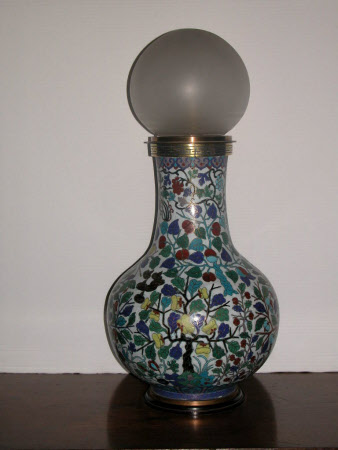Vase
Category
Historic Services / Lighting
Date
1825 - 1850
Materials
Enamel, Glass, Metal alloy
Measurements
457 mm (H)
Order this imageCollection
Cragside, Northumberland
NT 1228271.1
Caption
This Chinese cloisonné vase is one of four that were converted to lamps not once but twice, for two different technologies. William, 1st Lord Armstrong (1810–1900), was one of the great scientific innovators of the Victorian age, an immensely successful engineer and armaments manufacturer. He made Cragside a showcase for technology. When the Library was completed in 1872, the vases housed paraffin lamps with the latest Duplex (double) burners, invented in 1865. Electricity fascinated Armstrong. He attended Joseph Swan’s demonstration of his newly perfected incandescent electric lamp in 1879. In December 1880 Swan supervised the installation of his lamps at Cragside – the first house in the world to be lit by hydroelectricity, which was generated on the estate. The copper vase conducted current, and a wire inside dipped through a hole into ‘a small, insulated mercury cup’ – its contents highly poisonous – in the metal base, which was connected to the power wire. It had no switch: setting the vase onto the base turned it on, removing it turned it off.
Summary
One of a pair of cloisonné enamel bottle vases, possibly made in Guangzhou, Guangdong Province, China, 19th century. Decorated with stylised fruiting trees and vines on a white ground. Converted into stands for electric lamps in 1880, with globular glass shades.
Full description
In 1878, Cragside became the first private house to be lit by hydroelectricity. Arc lamps were originally used, but in 1880 vase lamps in the library were fitted with Joseph Swan’s newly invented filament light bulbs. A water-powered Siemens dynamo sent hydroelectricity into the house. The enamelled copper vases (Cloisonné) were originally chosen as they could be used as conductors for the electric current. As the light switch hadn’t been invented, the lamps were turned on by placing them over an insulated mercury cup. Armstrong described the arrangement in a letter to The Engineer, published 21 January 1881: [Four of the lamps] … are placed singly and in globes in various parts of the room, upon vases which were previously used as stands for duplex kerosine lamps. These vases being enamels on copper are themselves conductors, and serve for carrying the return current from the incandescent carbon to a metallic base in connection with the main return wire. The entering current is brought by a branch wire to a small insulated mercury cup in the centre of the base, and is carried forward to the lamp by a piece of insulated wire which passes through a hole in the bottom of the vase, and thence, through the interior, to the lamp on the top. The protruding end of this wire is naked, and dips into the mercury cup when the vase is set down. Thus the lamp may be extinguished and re-lighted at pleasure merely by removing the vase from its seat or setting it down again.
Provenance
Armstrong collection. Transferred by the Treasury to The National Trust in 1977 via the National Land Fund, aided by 3rd Baron Armstrong of Bamburgh and Cragside (1919 - 1987).


